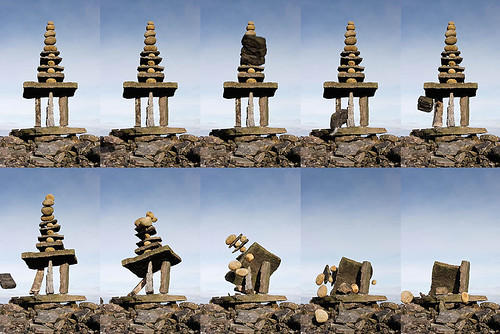A few days after I made this stack I received an email from Lancaster University asking me if I would enter something for their 'Experimentality' exhibition. They had asked me several weeks before that but I couldn't think of anything that would fit the theme and so I put it to the back of my mind.
This latest email came within a couple of days of the closing date and when I thought about it I reckoned the stills from this video would fit the experimentality theme as I realised that I hadn't witnessed or tried to witness the demise or collapse of a sculpture in such a way before.
So I took the ten stills that make up this timelapse and made them into a single picture, entered it and was very pleased to be chosen. (I am saving the actual picture for an upcoming book as it looks quite cool).
Quite a bit of luck was involved in capturing the stills for that video. I had not planned it and just gave it a go not expecting very much at all. The results were quite good
and now the exhibition has finished, the gallery has given me the printed picture and I have spent some time looking at it. I like the sculptural quality of each shot as it moves from its equlibrium point and gradually collapses from frame to frame (although this all happens in less than a second).
And so this accident of discovery spurred me on to get out there today and try again. Another thing I often find with my art is my first go is the best and that is why I rarely repeat the same sculpture but move onto something new. My first try always looks more fresh to me and so it was with these new attempts at playing with gravity. The pebbles on top of the pagoda stack all balanced the first time quite easily. In that incarnation they also looked the most symmetrical and elegant. Yet when I tried to knock it over I only succeeded in knocking the top off (as shown in this timelapse) and had to rebuild the balanced pebbles at the top. And this took a frustrating age... You may notice that single shot of each sculpture is different to the timelapses or composites and that is because I got each one 'right' first time but had to rebuild them again to collapse them, but each rebuild did not have the form of the original.
Why does it come so easily the first time only for it to be painfully difficult the second? I have experienced this so many times but cannot write it off as coincidental.
I tried several more stacks and attempted to capture each demise. A couple of times the wind beat me to it but after learning how best to collapse and capture each stack it left me bemused how the collapse of the temple stack was so perfectly captured and yet I didn't know what I was after and didn't try to do anything in a particular way. I call it the art of slack or following the line of least resistance. When I try to achieve something I often fail, when I just do without expectation I am often much more successful. Why? I don't know, but it seems to work for me.
You might think the second frame is the same as the first, but if you look closely you will see that the shadow of the thrown stone is coming in from the left.
Saturday, February 13, 2010
Pagoda Stack Collapse
Subscribe to:
Post Comments (Atom)












No comments:
Post a Comment